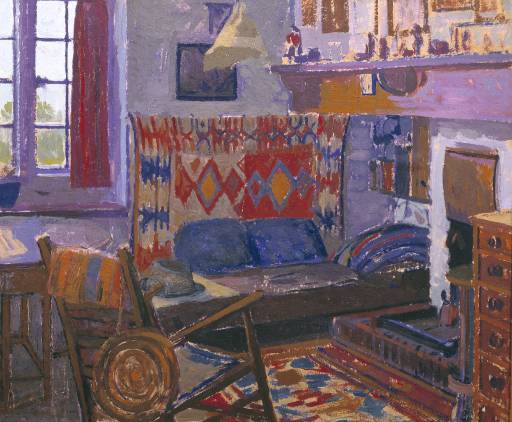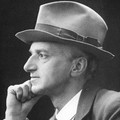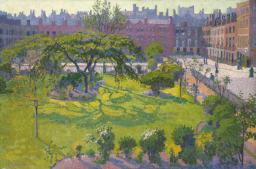William Ratcliffe The Artist's Room, Letchworth c.1932
© The estate of William Ratcliffe
William Ratcliffe,
The Artist's Room, Letchworth
c.1932
© The estate of William Ratcliffe
Around 1932 William Ratcliffe stayed at the home of Stanley Parker and his family, whose brother designed Letchworth Garden City and the house at 102 Wilbury Road, which is the subject of this painting. Ratcliffe uses an extensive palette of complementary colours, with little mixing, to describe the confluence of textures and objects collected in the room.
William Ratcliffe 1870–1955
The Artist’s Room, Letchworth
c.1932
Oil paint on paper
457 x 552 mm
Inscribed ‘W. Ratcliffe’ bottom left and ‘Interior Sketch, W. Ratcliffe, 102 Wilbury Road’ in ink on back
Presented by S.K. Ratcliffe, the artist’s brother 1955
T00062
c.1932
Oil paint on paper
457 x 552 mm
Inscribed ‘W. Ratcliffe’ bottom left and ‘Interior Sketch, W. Ratcliffe, 102 Wilbury Road’ in ink on back
Presented by S.K. Ratcliffe, the artist’s brother 1955
T00062
Ownership history
Probably inherited from the artist in 1955 by Samuel Kerkham [S.K.] Ratcliffe (1868–1958), the artist’s brother, by whom presented to Tate Gallery the same year.
Exhibition history
2002
Harold Gilman and William Ratcliffe, Southampton City Art Gallery, April–July 2002 (no catalogue number).
2003
Garden City into Camden Town: The Art of William Ratcliffe, Letchworth Museum and Art Gallery, September–October 2003 (70).
References:
1964
Mary Chamot, Dennis Farr and Martin Butlin, Tate Gallery Catalogues: The Modern British Paintings, Drawings and Sculpture, vol.2, London 1964, p.541.
Technique and condition
The Artist’s Room, Letchworth is painted on prepared paper marouflaged onto a paper plyboard. A handwritten ink inscription on the back reads: ‘Interior Sketch, W. Ratcliffe, 102 Wilbury Road’, describing the subject of the painting. The support is an off-white wove paper, which has been adhered to a paper plyboard which is slightly larger on all four sides.
The painting has the appearance of an oil sketch executed in situ. The paint is continuous to the edges on all four sides and pin holes in each corner pierce the paint indicating that the work was pinned up after painting. The technique is consistent with Ratcliffe’s other works in the Tate collection. There is some evidence of initial marking out in paint which was overlaid with opaque colour in contrasting coloured layers with areas of impasto. The paint is applied in directional strokes with the same size brush, following the contours of objects or spaces, and is stiff enough to retain the brushwork. Colour has been overlaid onto colour leaving the underlying hues exposed at the edges or beneath loosely applied paint. In some areas, such as the desk at the left and the hat, the artist has scrapped into overlying colour to reveal the colour beneath, probably using the end of the brush. The palette is extensive with a strong emphasis on warm purples, reds and oranges and little mixing. Spots of the primed paper are left unpainted at the edges of objects providing contrasting flecks of light across the surface. Where the directional light from the window is reflected from surfaces, such as the rug in the foreground and the area above the mantelpiece, the primed paper is left exposed in between opaque dashes of pure colour. Broad graphite lines in the foreground and painted outlines are used to delineate objects or compositional lines in the later stages of painting and the surface has been left unvarnished.
Sarah Morgan and Natasha Walker
June 2005
How to cite
Sarah Morgan and Natasha Walker, 'Technique and Condition', June 2005, in Robert Upstone and Helena Bonett, ‘The Artist’s Room, Letchworth c.1932 by William Ratcliffe’, catalogue entry, February 2011, in Helena Bonett, Ysanne Holt, Jennifer Mundy (eds.), The Camden Town Group in Context, Tate Research Publication, May 2012, https://wwwEntry
This picture shows the room where William Ratcliffe stayed at 102 Wilbury Road in Letchworth Garden City, the home of Stanley and Signe Parker and their family (figs.1–3). The house was specially designed for them in the Arts and Crafts tradition in 1908 by Stanley’s brother Barry Parker (1867–1947) and his partner Raymond Unwin (1863–1940), who were the key architects of Letchworth. It is now a Grade II listed building. The furniture shown in Ratcliffe’s painting is also in the Arts and Crafts style, and the scene overall reflects the relaxed, simple life that many people looked for in the Garden City.
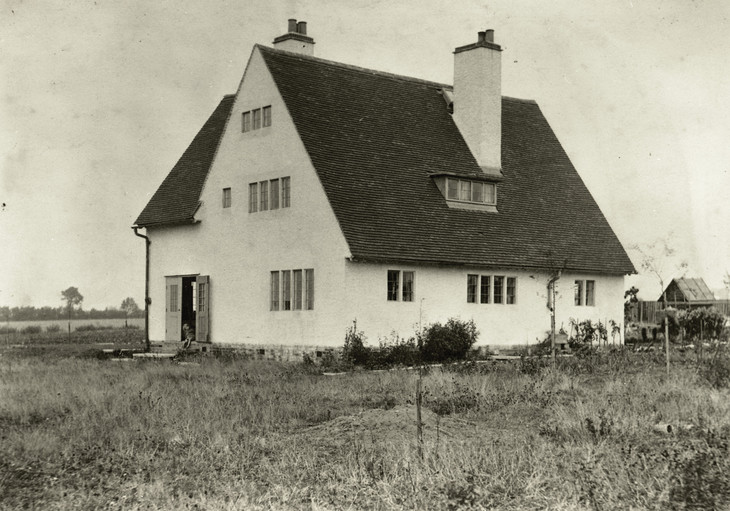
Stanley and Signe Parker's house, 102 Wilbury Road, Letchworth Garden City c.1910
First Garden City Heritage Museum
Photo © First Garden City Heritage Museum
Fig.1
Stanley and Signe Parker's house, 102 Wilbury Road, Letchworth Garden City c.1910
First Garden City Heritage Museum
Photo © First Garden City Heritage Museum
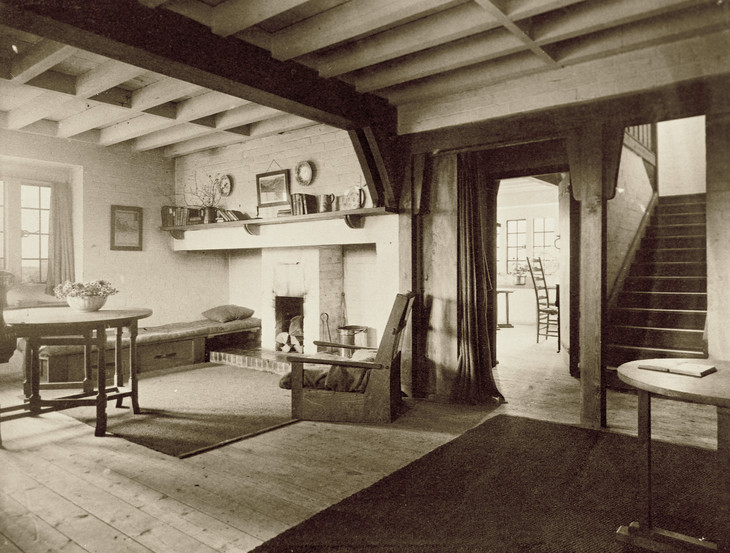
Interior of Stanley and Signe Parker's house, 102 Wilbury Road, Letchworth Garden City c.1909
First Garden City Heritage Museum
Photo © First Garden City Heritage Museum
Fig.2
Interior of Stanley and Signe Parker's house, 102 Wilbury Road, Letchworth Garden City c.1909
First Garden City Heritage Museum
Photo © First Garden City Heritage Museum
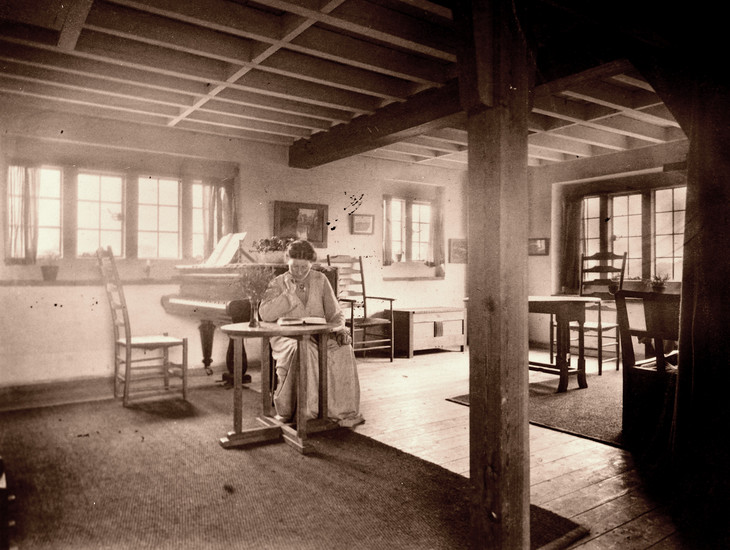
Signe Parker sitting in her house at 102 Wilbury Road, Letchworth Garden City c.1910
First Garden City Heritage Museum
Photo © First Garden City Heritage Museum
Fig.3
Signe Parker sitting in her house at 102 Wilbury Road, Letchworth Garden City c.1910
First Garden City Heritage Museum
Photo © First Garden City Heritage Museum
Probably influenced by his mentor Harold Gilman and other Camden Town Group members such as Spencer Gore, Ratcliffe painted many interiors over the years. In Cottage Interior c.1914 (fig.4), as with the Tate work, blues and purples are used to accentuate the cool indoor atmosphere in contrast to the bright sunshine outside. Touches of complementary oranges and yellows are used to add warmth. In The Artist’s Room the bold red patterns in the rug, wall hanging and curtain further enhance the intimacy of the scene. Cottage Interior portrays a recently executed painting, Summer Landscape, Sweden 1913 (Government Art Collection),1 propped against the wall. In Tate’s painting the artist’s presence is felt through his hat, depicted on a small table at the centre left of the composition.
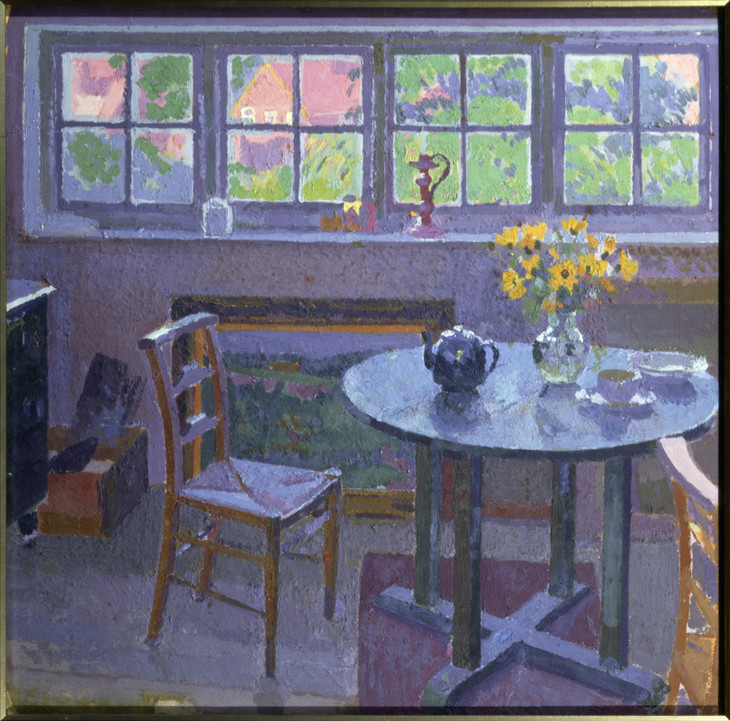
William Ratcliffe 1870–1955
Cottage Interior c.1914
Oil paint on pulpboard
495 x 495 mm
Private collection
© Estate of William Ratcliffe
Courtesy of Phillips Auctioneers and Wendy Baron
Fig.4
William Ratcliffe
Cottage Interior c.1914
Private collection
© Estate of William Ratcliffe
Courtesy of Phillips Auctioneers and Wendy Baron
After 1921 Ratcliffe mostly made only drawings and watercolours, and so an oil of this later date is somewhat unusual.3 The freely handled use of paint and the sketchiness of the design is in distinct contrast to his earlier oils, of which Clarence Gardens (Tate T03359) is a characteristic example. According to his friend, the artist William Townsend, Ratcliffe particularly liked this work.4
Robert Upstone and Helena Bonett
February 2011
Notes
Reproduced at the Government Art Collection, http://www.gac.culture.gov.uk/work.aspx?obj=20627 , accessed 25 February 2011.
Lisa Parker, letter to Tate Gallery, 6 February 1956, Tate Catalogue file. A photograph of Ratcliffe and Lisa Parker together c.1930 is reproduced in Patricia Williams, William Ratcliffe: A Country Walk, St Ives 2010, pl.15.
Related biographies
Related catalogue entries
How to cite
Robert Upstone and Helena Bonett, ‘The Artist’s Room, Letchworth c.1932 by William Ratcliffe’, catalogue entry, February 2011, in Helena Bonett, Ysanne Holt, Jennifer Mundy (eds.), The Camden Town Group in Context, Tate Research Publication, May 2012, https://www

